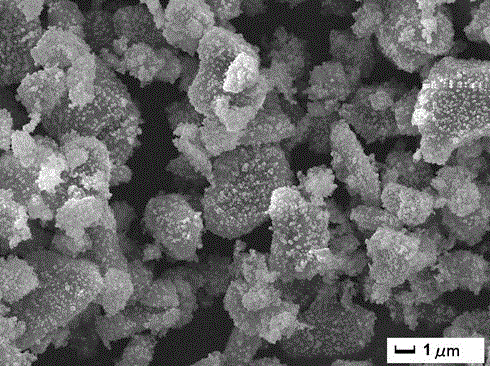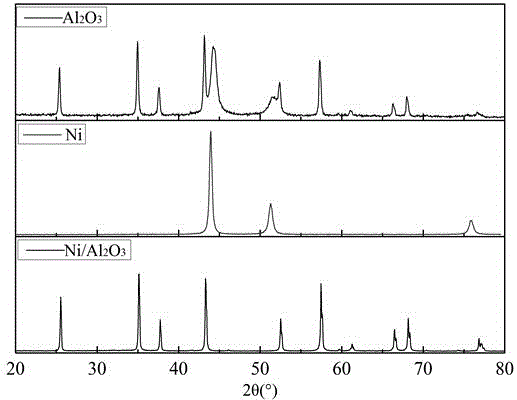Preparation method of magnetic micro/nano composite filler/silicon rubber heat-conducting composite material
A technology of thermally conductive composite materials and composite fillers, applied in the field of polymer-based thermally conductive composite materials, can solve the problems of low thermal conductivity of thermally conductive rubber, decreased material processability, poor thermal conductivity, etc., achieve uniform dispersion, avoid difficult dispersion, improve The effect of thermal conductivity
- Summary
- Abstract
- Description
- Claims
- Application Information
AI Technical Summary
Problems solved by technology
Method used
Image
Examples
Embodiment 1
[0026] Weigh 1.18g (5mmol) of nickel chloride hexahydrate (NiCl 2 ·6H 2 O), under stirring conditions, add 50ml of ethylene glycol until completely dissolved; weigh 2.5g of alumina micron particles with an average particle size of 3μm, add it to the ethylene glycol solution of nickel chloride, and continue stirring to make the alumina particles Disperse evenly; add dropwise sodium hydroxide solution until nickel hydroxide is fully formed during the stirring process; adjust the pH value of the solution to 10 to generate nickel hydroxide / alumina composite particles, and continue stirring for 30 minutes; add the aqueous solution of hydrazine hydrate dropwise until The reaction is complete, and then the reaction mixture solution is separated, washed 5 times with deionized water, and dried for 10 hours at 80°C to obtain 2.74g of nano-nickel / alumina composite thermally conductive filler, wherein the nano-nickel particles account for the mass of the composite thermally conductive fil...
Embodiment 2
[0032] Weigh 2.11g (5mmol) of ferric nitrate nonahydrate (Fe(NO 3 ) 3 9H 2O), add 50ml of ethylene glycol under stirring until completely dissolved; weigh 4.5g of boron nitride micron particles with an average particle size of 1μm, add it to the ethylene glycol solution of ferric nitrate, and continue stirring to make boron nitride The particles are uniformly dispersed; during the stirring process, add sodium hydroxide solution dropwise until ferric hydroxide is fully formed; adjust the pH value of the solution to 10 to generate ferric hydroxide / boron nitride composite particles, and continue stirring for 30 minutes; add sodium borohydride dropwise aqueous solution until the reaction is complete. Then the reaction mixture solution was separated, washed 5 times with deionized water, and dried at 80°C for 10 hours to obtain 4.73g of nano-iron / boron nitride composite filler, wherein the mass fraction of nano-iron particles in the composite thermally conductive filler was 5%. ....
Embodiment 3
[0037] Weigh 1.3g (5mmol) of nickel sulfate hexahydrate (NiSO 4 ·6H 2 O), add 50ml of ethylene glycol under stirring conditions until completely dissolved; weigh 4g of aluminum nitride micro-particles with an average particle size of 20μm, add it to the ethylene glycol solution of nickel sulfate, and continue stirring to disperse the aluminum oxide particles Uniformly; add dropwise sodium hydroxide solution until nickel hydroxide is fully formed during the stirring process; adjust the pH value of the solution to 10 to generate nickel hydroxide / aluminum nitride composite particles, and continue stirring for 30 minutes; add sodium borohydride aqueous solution drop by drop, until the reaction is complete. Then the reaction mixture solution was separated, washed 5 times with deionized water, and dried at 80°C for 10 hours to obtain 4.23g of nano-nickel / aluminum nitride composite filler, wherein the mass fraction of nano-nickel particles in the composite thermally conductive fille...
PUM
| Property | Measurement | Unit |
|---|---|---|
| particle diameter | aaaaa | aaaaa |
Abstract
Description
Claims
Application Information
 Login to View More
Login to View More - R&D
- Intellectual Property
- Life Sciences
- Materials
- Tech Scout
- Unparalleled Data Quality
- Higher Quality Content
- 60% Fewer Hallucinations
Browse by: Latest US Patents, China's latest patents, Technical Efficacy Thesaurus, Application Domain, Technology Topic, Popular Technical Reports.
© 2025 PatSnap. All rights reserved.Legal|Privacy policy|Modern Slavery Act Transparency Statement|Sitemap|About US| Contact US: help@patsnap.com



